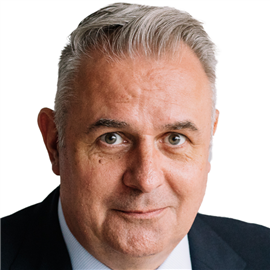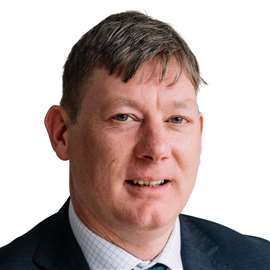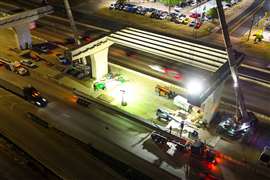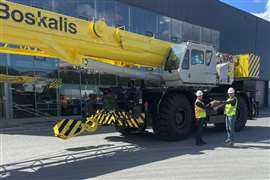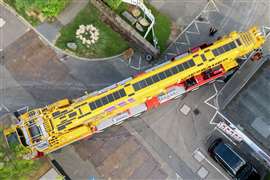Read this article in Français Deutsch Italiano Português Español
How the industry is making tricky transport moves smarter and safer
06 January 2025
The specialized transport industry is making big moves smarter, safer and more efficient. Niamh Marriott rounds up the latest news and moves
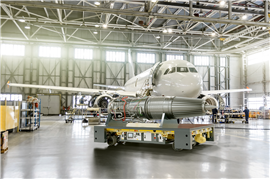 Luxembourg-based transport company Faymonville has created new products to help move large components. (Photo: Faymonville)
Luxembourg-based transport company Faymonville has created new products to help move large components. (Photo: Faymonville)
The specialized transport industry has come a long way in tackling the challenge of moving massive equipment and structures. At the forefront of this progress is the self propelled modular transporter (SPMT), a game changer in hauling the seemingly impossible. These multi-axle machines have become the go-to solution for industries dealing with supersized loads like wind turbines, industrial reactors, and bridge components.
What is really exciting is how SPMTs are getting smarter and more adaptable. Engineers are coming up with clever ways to handle increasingly heavy and complex cargos while navigating tighter spaces and tougher terrains. With cutting-edge controls, better modular setups, and innovations in load-balancing tech, SPMTs are meeting the growing demands of industries that constantly push limits.
Customisation
“Modern SPMT designs emphasise greater flexibility and adaptability, with features to meet diverse requirements like high axle loads,” says a spokesperson for specialized transport company Tii Scheuerle. “Scheuerle offers SPMT options that are easily configurable for different transport tasks, including specialized versions like the SPMT SL (split type), which can adapt to various width requirements, widening systems and spacers, and an Arctic Package variant for extreme climates down to -40°C.
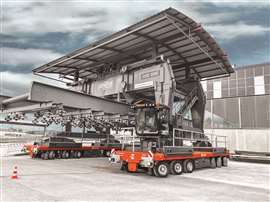 Swiss heavy transport specialist Friderici Spécial used SPMT PowerHoss modules from Tii Scheuerle for the Geneva Airport renewal project. (Photo: Tii Group)
Swiss heavy transport specialist Friderici Spécial used SPMT PowerHoss modules from Tii Scheuerle for the Geneva Airport renewal project. (Photo: Tii Group)
“The latest addition, Scheuerle Connect, integrates telematics, providing fleet management tools, remote diagnostics, and maintenance tracking for efficient operation and reduced downtime and can be even retrofitted in older generations.”
Scheuerle’s SPMTs have set benchmarks in heavy transport since their introduction. Over the decades, their models have continually pushed engineering boundaries to meet the diverse needs of industries worldwide.
“The original SPMT (1983) revolutionized the industry with modular designs allowing unlimited payloads and cross-generation compatibility,” says the spokesperson. “The PowerHoss series (2015) introduced a compact, user-friendly model for loads starting at 80 tonnes, scalable through coupling additional units. The SPMT K24 (1980s) remains a versatile solution for diverse heavy loads, bolstered by an array of accessories. Additionally, the InterCombi SPE offers a specialized option with electronic steering, dual tires, and a lowered height for enhanced stability and adaptability.”
Runway moves
Speaking on a recent project, Tii’s spokesperson added, “The Swiss heavy transport specialist Friderici Spécial has integrated four 6-axle SPMT PowerHoss modules from Tii Scheuerle into their fleet, marking a significant advancement in the renewal of Geneva Airport’s runway. These modules have been deployed as replacement chassis for two aging gantry cranes, enabling precise handling and manoeuvring of 180 tonne concrete slabs during overnight operations. This ensures that daytime flight schedules remain unaffected.
“The SPMT PowerHoss features integrated drive units and plug-and-play operation, making it ideal for confined spaces such as tunnels, ware-houses, and runways. Its versatility extends beyond this project, offering solutions for industries such as energy, construction, and logistics.
“Friderici Spécial has also set a milestone by obtaining Swiss Motor Vehicle Control (MFK) approval, allowing the PowerHoss to operate on public roads. During testing, the modules demonstrated their capabilities in transporting heavy components like trans-formers and tunnel boring machine parts under challenging conditions, including con-fined spaces and steep inclines.
“This project showcases the flexibility, reliability, and cost-efficiency of the SPMT PowerHoss, proving its value as a multifunctional transport solution for long-term projects and beyond.”
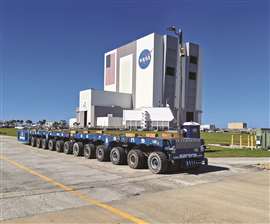 To construct NASA’s new mobile launcher, Sarens used Scheuerle’s K24 SPMTs. (Photo: Tii Group/ Sarens)
To construct NASA’s new mobile launcher, Sarens used Scheuerle’s K24 SPMTs. (Photo: Tii Group/ Sarens)
Line order
Heavy lift giant Sarens recently purchased additional Scheuerle SPMT K24 axle lines from Tii Group. The company now have nearly 2,000 SPMT K24 axle lines in its fleet.
Sarens uses SPMT K24 modular transporters for a broad spectrum of applications, including transporting oil-and-gas platform modules, entire bridges, and other oversized and heavy components, in shipyards, construction, and mining sites.
Transport specialist Baumann has invested in Cometto self propelled modular transporter (SPMT) axle lines.
In mid-October representatives from the German company travelled to the Cometto factory in Italy. They inspected the 24 axle lines of equipment they had ordered which, in addition to the 48T series of SPMT, included two power pack units.
Baumann has worked in heavy transport for more than 130 years. It has sites in Bornheim, Dormagen and Neuss. Loads weighing as much as 1,000 tonnes have been moved by the German specialist.
Navantia Seanergies also recently placed an order with Cometto for 72 axle lines of MSPE 48T self prepelled modular transporter.
The Spanish offshore wind and hydrogen technology company will use its new equipment to move monopile foundations for wind turbines where it builds them at the Spanish coastal town of Fene in the very north west of the country.
The SPMT will carry the monopiles from the production facility to the storage area and then out to the loading barge. Current monopiles weigh up to 2,000 tonnes but they are expected to get bigger and heavier as the size of wind turbines continues to increase.
Wind work
Many crane and specialized transport companies are finding a plethora of work in the wind energy sector. Luxembourg-based transport company Faymonville has created new products to help move large wind turbine components to their construction sites.
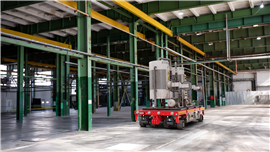 Faymonville hosted a WindMover Days event for the wind power transport industry. (Photo: Faymonville)
Faymonville hosted a WindMover Days event for the wind power transport industry. (Photo: Faymonville)
“Renewable energies have been an important topic for some time,” says a spokesperson for the family-run company. The Faymonville Group’s recent WindMover Days event earlier this year highlighted the company’s dedication to the evolving wind power industry by showcasing specialized transport solutions for increasingly larger wind tower elements and rotor blades.
“The wind power industry in particular is subject to continuous development. Offshore systems and wind farms are growing continuously, as are the dimensions of the wind tower elements and rotor blades – and with them the transport challenges.”
Over four days, around 250 industry experts explored Faymonville’s high-tech offerings, including the WingMax flatbed trailer, Cometto BladeMax1000, and various self-steering and low loader trailers designed for efficient and safe wind turbine component transport.
These innovations not only enhance transport capabilities but also reduce costs and environmental impact.
Safe with Sarens
Global heavy lift leader Sarens played a key role in installing an innovative wooden bicycle and pedestrian bridge at the Vierarmen junction in Tervuren, Belgium, for its client Viabuild. The 278 tonne bridge spans 67.5 meters and is part of the F29 cycle highway connecting Brussels and Leuven.
For the installation, Sarens used four CS250 towers, eight SPMTs, custom transport stools, and 100 tonne jacks. Transporting equipment from across Europe required 24 trucks, with assembly completed in three days, thanks to meticulous planning at Sarens’ Wolvertem depot. The versatile CS250 towers allowed efficient jacking under the pre-assembled bridge, meeting the eight-hour overnight road closure limit.
This landmark project is part of the ‘Werken aan de Ring’ programme, promoting sustainable mobility by creating safe, eco-friendly infrastructure. Constructed entirely from European wood, the bridge is the largest of its kind in Flanders, Sarens says. Manufacturer Amann contributed to the design and strength calculations and supplied custom wooden support blocks to protect the bridge during transport.
Previously a hazardous crossing, the Vierarmen junction is now a safe, seamless connection for cyclists and pedestrians. Sarens’ expertise in large-scale projects is evident in similar undertakings, including the OA14 bridge in Luxembourg, pedestrian bridges in France, and major railway bridges in Amsterdam and Stockholm.
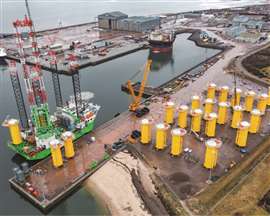 Mammoet marshalling in Belgium. (Photo: Mammoet)
Mammoet marshalling in Belgium. (Photo: Mammoet)
The Îles d’Yeu and Noirmoutier offshore wind farm, 12km from Île d’Yeu and 16km from Île de Noirmoutier, is France’s fifth operational offshore wind project. Featuring 61 wind turbines with a capacity of 8MW each, it will produce 1,900GWh annually, powering approximately 800,000 people.
Longtime partner BOW Terminal engaged Mammoet to handle the marshalling, transport, and temporary storage of 400 tonne, 30 metre high transition pieces (TPs) fabricated in Belgium. Traditionally, TPs are moved with crawler cranes or gantry-equipped SPMTs, requiring complex assembly and rigging. For this project, Mammoet introduced the TPH800, an attachment that transforms SPMTs into giant forklifts, enabling faster, safer TP handling.
Each TP arrived at BOW Terminal Vlissingen by barge in groups of four, was lifted to the quay by a 1,200 tonne crawler crane, and placed on concrete supports. SPMTs, equipped with the TPH800, collected the TPs, moved them to storage, and later transported them back to the quayside setup area. The TPH800, with its 800 tonne lift capacity, simplifies handling by slotting forklift-like beams under the TPs, securely locking them in place for transport.
While the TPH800 can facilitate crane-free roll-on/roll-off operations, cranes were used here to avoid complications from Vlissingen’s four-meter tidal changes, ensuring 24/7 operational efficiency.
ESTA manifesto
A five year manifesto for specialized transport in Europe has been published by the European Association of Abnormal Road Transport and Mobile Cranes (ESTA).
In the manifesto ESTA sets out its priorities for abnormal road transport over the next five years. It highlights the organisation’s medium-term strategic transport priorities from now until 2029.
The manifesto, titled Competitive and Harmonised Abnormal Transport in Europe, will help support ESTA’s mission to improve safety and efficiency in Europe’s heavy transport sector.
Commenting on the move Ton Klijn, ESTA director, said, “There is a growing level of political activity in the transport sector as our national leaders become increasingly aware of the importance of the work being carried out by our members.
“Now it is essential that those same political leaders appreciate the need for a co-ordinated approach that crosses European borders and boundaries if the potentially great gains for industry and our clients are to be captured and not lost. We hope our manifesto will help to drive that debate forward.”
ESTA is also backing revision of the EU Weights and Transport Directive under discussion by the authorities in Brussels.
On the second priority ESTA has already been working on creation of a network of safe and secure parking places for abnormal transport to both boost the industry’s productivity and also help with the recruitment of the next generation of drivers.
In addition, given the growing importance of abnormal road transport between various European industrial areas, ESTA is increasingly hopeful that its calls for the introduction of “abnormal transport corridors” within the trans-European road network will begin to garner serious support.
Such corridors would allow abnormal transport to run smoothly and avoid potential damage of infrastructure, that is not adapted to abnormal road transport weights and dimensions.
EXG’s Saudi transport
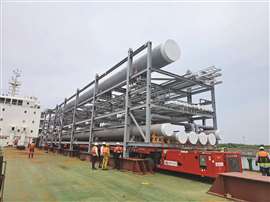 Multiple challenges were overcome in a Saudi module move. (Photo EXG)
Multiple challenges were overcome in a Saudi module move. (Photo EXG)
Express Global Logistics (EXG) in India transported and loaded out modules, each weighing up to 250 tonnes, for an energy project in Saudi Arabia.
The 14 modules, for a large green hydrogen project, were moved and placed using self propelled modular transporter (SPMT) from Scheuerle. There were 48 axle lines of SPMT, two power pack units (PPU) and specially designed spacers.
The modules were 50 metres long, 12 metres wide and 18 metres tall. Together all the modules were 1,500 FRT (freight tonnes).
For the load out of eight of the modules it was a roll-on roll-off (RoRo) operation. On their SPMT the modules were loaded onto the vessel with ramp plates and stools before fastening for the voyage. The vessel was ballasted for stability.
The other six modules were transported on SPMT to the jetty and lifted into position on the vessel using crawler cranes.
EXG designed the spacers for the SPMT to accommodate the load length and maintain structural integrity of the PAR and PAU modules during the loadout.
Protrusions on the superstructure of the vessel were avoided by using the suspension travel of the SPMT. Ballasting was closely co-ordinated as the SPMT was driven on. Limitations of the mooring winches meant the operation had to be carefully managed in a limited time as the tide rose.
“The seamless execution of this project highlights the exceptional capabilities of our in-house engineering team and operational crew,” EXG said, describing it as an intricate operation to transport the heavy modules from the client’s yard to the designated jetty.
STAY CONNECTED


Receive the information you need when you need it through our world-leading magazines, newsletters and daily briefings.
CONNECT WITH THE TEAM

